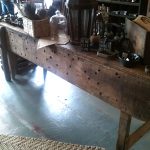We may receive a commission when you use our affiliate links. However, this does not impact our recommendations.
Q & A: Slot Cutter vs. Plate Joiner
Q:I saw an ad for a slot-cutting router bit. I have a router A:It depends on what kind of joints you plan to make.A slot • A butt-corner joint (Photo 4) can be made, but requires the • On a tee-butt joint (Photo 5) you can rout the end slot but • A corner miter (Photo 6) is best handled using the slot A plate joiner (photo below), on the other hand, |
Click any image to view a larger version. Cutting angle joints with a plate joiner |
SourceNote: Product availability and prices are subject to change. Woodcraft, woodcraft.com, 800-225-1153, This story originally appeared in American Woodworker June 2001, issue #87. |
|
Here are some supplies and tools we find essential in our everyday work around the shop. We may receive a commission from sales referred by our links; however, we have carefully selected these products for their usefulness and quality.










![Woodworking Prime Day Deals 2024 [Updated for Day 2]](http://www.popularwoodworking.com/wp-content/uploads/bfi_thumb/dummy-transparent-olcy6s63it1p9yp7uhusjas7c8kahafrhg9su7q9i0.png)


